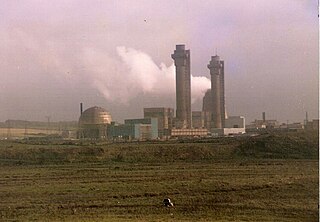 W
WThe Atomic Energy Research Establishment (AERE) was the main centre for atomic energy research and development in the United Kingdom from 1946 to the 1990s. It was created, owned and funded by the British Government.
 W
WThe Atomic Weapons Establishment (AWE) is a United Kingdom Ministry of Defence research facility responsible for the design, manufacture and support of warheads for the UK's nuclear weapons. It is the successor to the Atomic Weapons Research Establishment (AWRE) with its main site on the former RAF Aldermaston and has major facilities at Burghfield, Blacknest and RNAD Coulport.
 W
WChapelcross nuclear power station is a decommissioned and partly demolished Magnox nuclear power station near Annan in Dumfries and Galloway in southwest Scotland, which was in operation from 1959 to 2004. It was the sister plant to the Calder Hall plant in Cumbria, England; both were commissioned and originally operated by the United Kingdom Atomic Energy Authority. The primary purpose of both plants was to produce weapons-grade plutonium for the UK's nuclear weapons programme, but they also generated electrical power for the National Grid.
 W
WSellafield is a large multi-function nuclear site close to Seascale on the coast of Cumbria, England. As of August 2020, activities at the site include nuclear fuel reprocessing, nuclear waste storage and nuclear decommissioning, and it is a former nuclear power generating site. The licensed site covers an area of 265 hectares and comprises more than 200 nuclear facilities and more than 1,000 buildings. It is Europe's largest nuclear site and has the most diverse range of nuclear facilities in the world situated on a single site.
 W
WSpringfields is a nuclear fuel production installation in Salwick, near Preston in Lancashire, England. The site is currently operated by Springfields Fuels Limited, under the management of Westinghouse Electric UK Limited, on a 150-year lease from the Nuclear Decommissioning Authority. Since its conversion from a munitions factory in 1946, it has previously been operated and managed by a number of different organisations including the United Kingdom Atomic Energy Authority and British Nuclear Fuels. Fuel products are produced for the UK's nuclear power stations and for international customers.
 W
WThe Windscale fire of 10 October 1957 was the worst nuclear accident in the United Kingdom's history, and one of the worst in the world, ranked in severity at level 5 out of a possible 7 on the International Nuclear Event Scale. The fire took place in Unit 1 of the two-pile Windscale facility on the northwest coast of England in Cumberland. The two graphite-moderated reactors, referred to at the time as "piles", had been built as part of the British post-war atomic bomb project. Windscale Pile No. 1 was operational in October 1950 followed by Pile No. 2 in June 1951.
 W
WThe Windscale Piles were a pair of air-cooled graphite-moderated nuclear reactors on the northwest coast of England in Cumberland. The two reactors, referred to at the time as "piles", were built as part of the British post-war atomic bomb project.
 W
WWinfrith Atomic Energy Establishment, or AEE Winfrith, was a United Kingdom Atomic Energy Authority site near Winfrith Newburgh in Dorset. It covered an area on Winfrith Heath to the west of the village of Wool between the A352 road and the South West Main Line.